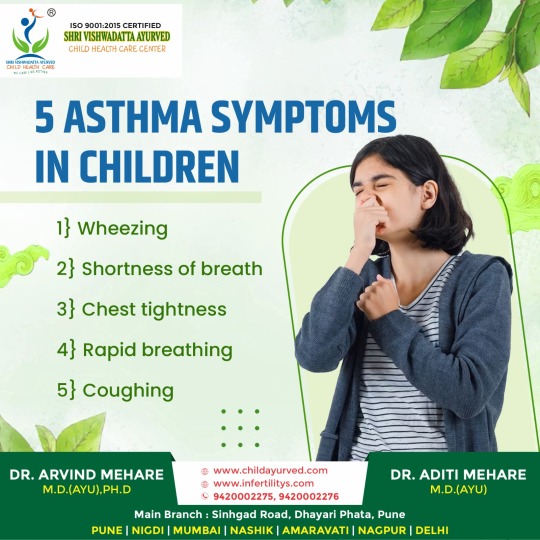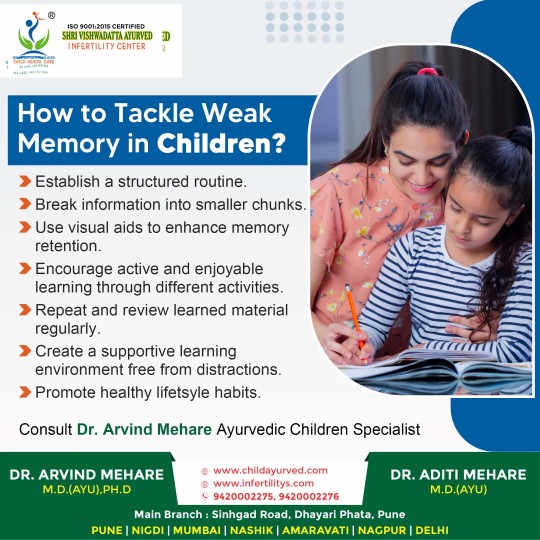#ADHDtreatmentforchildinPune
Text
Dr. Arvind Mehare- Ayurvedic Child Specialist in Delhi | Treatment for down syndrome | Height Increase | Autism Treatment
#ayurvedatreatment#childautismtreatmentinindia#adhdtreatmentforchildinpune#ayurvedicmedicine#autismtreatmentforchildreninpune#childayurvedicspecialistinpune#delhi
0 notes
Text

ASTHMA SYMPTOMS IN CHILDREN- Ayurvedic Child Specialist in Pune
5 ASTHMA SYMPTOMS IN CHILDREN
1. Wheezing
2. Shortness of breath
3. Chest tightness
4. Rapid breathing
5. Coughing
#asthma#astmasymptoms#symptomsofasthma#wheezing#shortbreath#shortnessofbreath#chesttigness#chesttight#tightnessinthechest#RapidBreathing#breathrapidly#coughing#cough#childayurved#ayurvedic#autismtreatmentforchildreninpune#adhdtreatmentforchildinpune#ayurvedicmedicine#ayurvedatreatment
0 notes
Text

How to tackle weak memory in children?
Consult with Ayurvedic Child Specialist- Dr Arvind Mehare Learning & Speech Disorder Treatment
#ayurvedic_child_specialist#ayurvedic_treatment_for_chidlren#weak_memory_in_children#ayurvedic_autism_treatment#ayurvedic_adhd_treatment#childautismtreatmentinindia#ayurvedicmedicine#ayurvedatreatment#adhdtreatmentforchildinpune#amaravati#autismtreatmentforchildreninpune#childayurvedicspecialistinpune#ayurved#ayurvedic
0 notes
Text
https://www.childayurved.com
Ayurvedic Child Specialist in Pune | Dr. Arvind Mehare
Dr. Arvind Mehare is a well reputed Ayurvedic child specialist in Pune as well as in India. Dr. Arvind Mehare focuses on Ayurvedic treatment for children such as treatment for common childhood problems, height weight and development disorders, common allergies and sensitivity disorders, learning and speech disorders and phobia disorders
#autismtreatmentforchildreninpune#childautismtreatmentinindia#adhdtreatmentforchildinpune#childayurvedicspecialistinpune#ayurvedatreatment#ayurvedicmedicine#childspecialist#ayurvedicspecialist
0 notes
Text
Do you know about Cerebral Palsy?
Cerebral palsy (CP) is a series of mobility and postural disorders that limit activities and are thought to be caused by non-progressive abnormalities in the baby brain.
The most prevalent and expensive type of chronic motor disability that first manifests in childhood is cerebral palsy (CP). In addition to epilepsy and secondary musculoskeletal issues, the motor abnormalities are frequently accompanied with difficulties of sensation perception, connection, communication, and behavior. A wide range of developmental, genetic, metabolic, ischemic, viral, and other acquired etiologies that result in a similar set of neurologic symptoms are responsible for cerebral palsy (CP). Neurologic involvement pattern, neuropathology, and etiology are the three main categories used to classify CP. Many people with CP function at high levels of schooling and employment, showing no signs of impairment.
In contrast to palsy, which refers to the loss or impairment of motor function, cerebral refers to the brain. The cerebral cortex, the part of the brain that controls how muscles move, is affected by cerebral palsy. In certain cases, the cerebral motor cortex did not develop normally throughout early childhood. In a different case, the harm was brought on by a brain injury that occurred either before, during, or after birth. In either situation, the damage is irreparable, and the resulting disabilities are permanent.
What causes cerebral palsy (CP)?
The condition known as cerebral palsy (CP) is brought on by either damaged or abnormally developing parts of the brain that control movement. This harm may develop prior to, during, or soon after birth. Although it might not be discovered for several months or even a year, the majority of children have congenital cerebral palsy.
The causes of cerebral palsy (CP) are–
Brain infections such as bacterial meningitis or viral encephalitis.
Problem with blood flow to the brain
Head injury (intracranial hemorrhage or bleeding inside brain)
Genetic abnormalities
Congenital brain malformation
Maternal infections on fever
Damage to the white matter of the brain (periventricular leukomacia or PVL)
Severe back of oxygen in the brain
Severe material low blood pressure rupture of uterus, detachment of placenta
Problems involving the umbilical cord
Early symptoms of cerebral palsy (CP) include:
Though a precise diagnosis may not be made until a child is two years old or more, cerebral palsy (CP) science typically manifests in the first month of life. Infants with CP often have developmental delays, which cause them to take longer than usual to attain developmental milestones like:
Learning how to sit, roll over, crawl, or walk.
Altered muscular tone can be present in some newborns with CP.
Hypotonic, or decreased muscle tone, can make them appear stiff or inflexible.
Hypertonia, or increased muscle tone, can make someone appear stiff or inflexible.
strange position
Prefer one side of the body when bending, crouching, or reaching.
Types of cerebral palsy (CP):
The distinct types of cerebral palsy (CP) can be distinguished by:
Spastic Cerebral Palsy
Dyskinesia Cerebral Palsy
Ataxic Cerebral Palsy
Spastic Cerebral Palsy
The most normal type of the condition is one in which the youngster moves awkwardly and with stiff muscles.
Forms of specific cerebral palsy include-
Specific diplopia/ diparesis involves muscle stiffness that is predominantly in the leg and less severely affect the arms and face.
Spasticquadriplegia/ quadriparesis is the most severe form of cerebral palsy and is often associated with moderate-to-severe intellectual disability. Children will often have severe stiffness in their Limbs but a floppy neck they are rarely able to walk. Speaking and being understood are difficult.
Dyskinesia cerebral palsy– is characterized by slow and uncontrollable writing or jerky movements of the hands, feet, arms or leg. Hyperactivity in the muscles of the face and tongue make some children grimace or drool. They find it difficult to sit straight or walk. Some children have a problem hearing, controlling their breathing.
Ataxic cerebral palsy affect balance and depth perception. Children with ataxic cerebral palsy will often have poor coordination and walk unsteadily with a wide based gait. They have difficulty with a quick or precise movements. Such as writing for or buttoning a shirt or a hard time controlling voluntary movements such as reaching for a book.
Symptoms appears in cerebral palsy:-
Children with cerebral palsy (CP) following symptoms including
Lack of muscle coordination when performing voluntary movement
Stiff and tight muscle and exaggerated reflexes.
Weakness in one or more arm and leg
Walking on the toes a croached gait or a scissored gain
Variations in muscle tone either to stiff or to floppy
Excessive drooling or difficulty swallowing or speaking
Shaking or random involuntary movements
Delays in reaching motor skill milestones
Difficulty with precise movements such as writing or buttoning a shirt
Intellectual disability
Abnormal physical sensation
Impaired vision
Hearing, language and speech problems
Delayed growth and development
Learning difficulties
Dental problems
Contractures
Malnutrition, inactivity
#ChildAyurvedicSpecialistinPune#AutismTreatmentforchildreninPune#CerebralpalsytreatmentForchildinPune#TreatmentfordownsyndromechildinPune#ADHDtreatmentforchildinPune#ChildautismtreatmentinIndia#HeightincreasetreatmentinIndia
0 notes
Text
ADHD (attention deficit hyperactivity disorder) in children
ADHD is one of the most frequent neuropsychiatric disorders in children. Children with ADHD have variations in brain growth and activity, which influence their attention, capacity to sit still, and self-control. ADHD can have an impact on a child's performance at school, at home, and in social situations.
ADHD affects 2 to 7% of people worldwide each year. In India, almost 10 million instances of ADHD are diagnosed each year.
The majority of ADHD patients have unknown aetiology. It is thought to be caused by a combination of genetics, environment, and social factors, with some cases linked to earlier brain infection or trauma. Genetic factors are also thought to play a role in determining whether CHD persists into adulthood.
Aside from heredity, other probable cases and risk factors include brain injury, environmental exposure during pregnancy or at a young age. (for example, lead), use of alcohol and tobacco during pregnancy, early delivery, low birth weight, and delayed pregnancy (age above 32 to 35).
Deciding if a child has ADHD is a multi-stage process; there are many other problems such as anxiety, depression, sleep problems, and certain types of learning disabilities that can have similar symptoms. The process usually includes a checklist for rating ADHD symptoms and taking a history of the child from parents, teachers, and sometimes the child.
Symptoms of ADHD-
ADHD symptoms are classified into two kinds.
Behavioral issue
A child who develops a pattern of inattention may frequently:
Paying inadequate attention to details or making careless mistakes in schoolwork
Have difficulty focusing on activities or playing
Have difficulty focusing on activities or playing
Have difficulties following directions and failing to complete schoolwork or duties
Having difficulty coordinating chores and activities
Avoid or dislike jobs requiring concentrated mental effort, such as schoolwork.
Items required for chores or activities, such as toys, school assignments, and pencils, can be misplaced.
Are easily distracted.
Forget to perform some everyday activities, such as chores.
Impulsiveness and hyperactivity
A child that shows a pattern of hyperactive and impulsive behaviour may frequently:
Fidget, tap his or her hands or feet, or wiggle in his or her seat
Have trouble keeping sitting in class or in other situations
Be always on the move.
When it is not proper to run around or climb,
Having difficulty playing or conducting an activity quietly
Too much talking
Interrupt the questioner by blurting out answers.
Have trouble waiting for his or her turn
Interrupt or intrude on the talks, games, or activities of others.
ADHD vs. typical developmental behaviour
Most healthy children are inattentive, hyperactive, or impulsive at some point in their lives. Preschoolers typically have limited attention spans and are unable to focus on a single activity for long periods of time. Even in older children and teenagers, attention span is frequently determined by amount of interest.
The same can be said about hyperactivity. Young children are naturally lively, and they often remain so long after they've exhausted their parents. Furthermore, some children are just inherently more active than others. Children should never be labelled as having ADHD simply because they differ from their peers or siblings.
Children who struggle in school but do well at home or with friends are most likely suffering from anything other than ADHD. The same is true for youngsters who are hyperactive or inattentive at home but have no effect on their academics or friendships.
When should you see a doctor?
If you are concerned that your child may be suffering from ADHD, consider ADHD treatment for your child. ADHD treatment for children are provided at Shri Vishwadatta Ayurved and have been shown to be successful.
#ChildAyurvedicSpecialistinPune#AutismTreatmentforchildreninPune#ADHDtreatmentforchildinPune#HeightincreaseTreatmentinPune#ChildautismtreatmentinIndia#HeightincreasetreatmentinIndia
0 notes